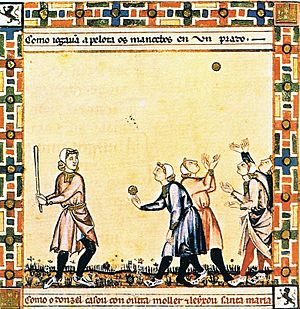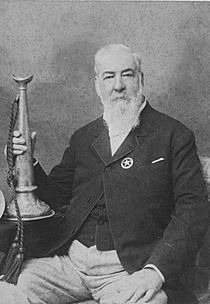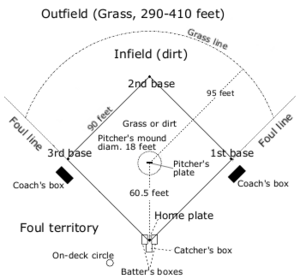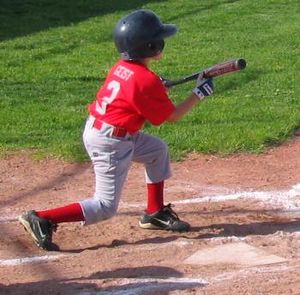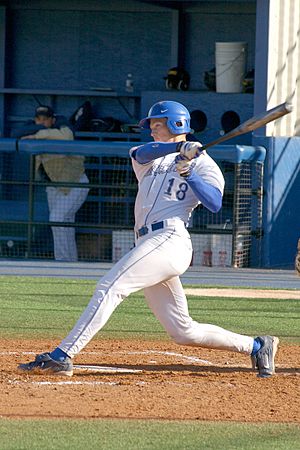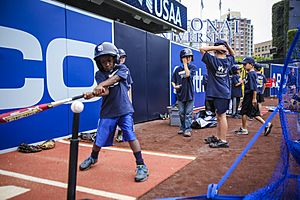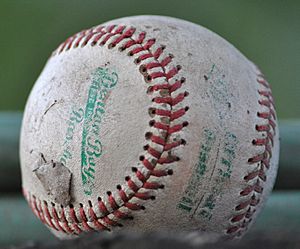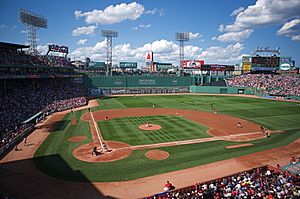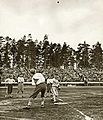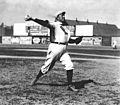Baseball facts for kids
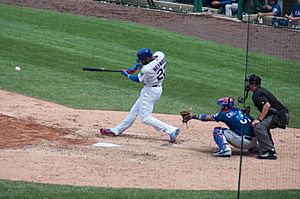
Jason Heyward of the Chicago Cubs hits a ball pitched to him during a game against the Texas Rangers in 2016.
|
|
| Highest governing body | World Baseball Softball Confederation |
|---|---|
| First played | 18th-century England, United Kingdom (predecessors) 19th-century United States (modern version) |
| Characteristics | |
| Contact | Limited |
| Team members | 9 |
| Mixed-sex | Yes, separate competitions |
| Type | Team sport, bat-and-ball |
| Equipment | Baseball Baseball bat Baseball glove Batting helmet Catcher's gear |
| Venue | Baseball park Baseball field |
| Glossary | Baseball Glossary |
| Presence | |
| Country or region | Worldwide (most prominent in the Americas, Caribbean, and East Asia) |
| Olympic | Demonstration sport: 1912, 1936, 1952, 1956, 1964, 1984 and 1988 Medal sport: 1992–2008, 2020– |
| World Games | 1981 |
Baseball is a sport played by two teams, with nine players on each team. In baseball, one team throws a small round ball called a baseball. The other team tries to hit it with a club called a bat. Teams score points by running and touching special markers on the ground called bases. They must touch all bases until they reach the last one, called home plate.
Baseball started in the United States in the 1700s and 1800s. Historians are not sure who invented it. Many people in North America, South America, and East Asia play baseball. In the United States, baseball is often called the national pastime. This is because many people used to spend a lot of time playing or watching baseball games. Today, though, many Americans follow football more than baseball.
Contents
History of Baseball
It is hard to know exactly how baseball grew from older bat-and-ball games. Some old French games seem to be related to baseball. Many people once thought that today's baseball came from an older game called rounders. Rounders was popular in Great Britain and Ireland.
However, a book from 2005 called Baseball Before We Knew It suggests that baseball actually started in England. New historical facts support this idea. The book says that rounders and early baseball were like different versions of the same game. It suggests that baseball's closest relatives are the English games of stoolball and "tut-ball."
The first known mention of baseball is in a British book from 1744. It is called A Little Pretty Pocket-Book. This book has a poem about "base-ball" and a picture. The picture shows a field that looks a bit like a modern baseball field. But it was shaped like a triangle instead of a diamond. Also, it had posts instead of bases on the ground.
The first recorded game of "Bass-Ball" happened in 1749 in Surrey, England. The Prince of Wales even played in this game. An English lawyer, William Bray, wrote about a baseball game in 1755. This early form of the game was likely brought to Canada by English people. Rounders also came to the United States from Canadians.
The first American mention of baseball was in 1791. A town in Pittsfield, Massachusetts made a rule against playing the game near its new meeting house. By 1796, a version of the game was well-known. A German scholar wrote about "englische Base-ball" in his book. He said the batter had three tries to hit the ball.
By the early 1830s, people were playing many different bat-and-ball games in North America. These games were like early forms of baseball. They were often called "town ball" or "round-ball."
These early games had some things similar to modern baseball. But they also had big differences. For example, some games had five bases. Also, a batter could be out if a hit ball was caught after it bounced once.
A popular story used to say that Abner Doubleday invented baseball in Cooperstown, New York, in 1839. But sports historians have shown that this story is not true.
In 1845, Alexander Cartwright helped create the "Knickerbocker Rules" in New York City. These rules changed the game a lot. For example, players could no longer get a runner out by hitting them with a thrown ball. The rules also made the ball smaller and harder. Many other rules made the Knickerbockers' game very close to modern baseball. However, a ball caught after the first bounce was still an out. Also, only underhand pitching was allowed.
The first official baseball game in U.S. history happened on June 19, 1846, in Hoboken, New Jersey. The "New York Nine" beat the Knickerbockers, 23–1, in four innings. The Knickerbocker rules became the base for modern baseball. The rules kept changing over the next 50 years.
How Baseball is Played
A baseball game is played by two teams on a baseball field. Each team has nine players. There are also umpires. Umpires watch carefully to make calls and make sure everyone follows the rules.
A baseball field has four bases. These bases form a diamond shape. The starting base is called home plate. Home plate is a five-sided shape. First base is on the right side of the field. Second base is at the top of the infield. Third base is on the left side of the field. Home plate is at the back of the field, where the catcher plays.
The game is played in innings. Professional and college baseball games have nine innings. In each inning, both teams get one turn to bat. They try to score runs, which are worth one point.
When one team bats, the other team plays defense. The defense tries to get three players from the batting team out. The team playing defense always has the ball. This is different from many other team sports. When the defense gets three players out, it becomes their turn to bat and score runs. Then the teams switch roles. After nine innings, the team with the most runs wins. If the score is tied, they play more innings until one team wins. At the start of the game, the home team pitches, and the visiting team bats. Only one player can bat at a time.
The baseball field, or diamond, has two main parts: the infield and the outfield. The infield is where the four bases are. The outfield is beyond the bases, when looking from home plate. The lines from home plate to first base and home plate to third base are the foul lines. The ground outside these lines is called foul territory.
A ball hit between the foul lines is a fair ball. The batter and runners can try to run around the bases and score. A ball hit outside the foul lines is a foul ball. If a foul ball hits the ground, the batter continues to bat. Any runners must go back to the base they were on. If the batter has fewer than two strikes, a foul ball counts as a strike. If the batter already has two strikes, a foul ball (not caught) means the batter keeps hitting. If a fielder catches a ball in the air, whether fair or foul, the batter is out.
The most important part of the game is between the pitcher and the batter. The pitcher throws, or pitches, the ball towards home plate. The pitcher usually throws the ball close enough for the batter to hit it. If the pitcher throws the ball in the "strike zone," it is a "strike." The strike zone is the area over home plate between the hitter's knee and chest. If the batter swings and misses, it is also a strike. Three strikes are a "strikeout," which is one way to get an "out."
A pitch that the batter does not swing at, and which is not a strike, is a "ball." If a pitcher throws four "balls," the batter "walks" to first base. So, it is important for pitchers to throw well.
The catcher for the pitcher's team waits behind the batter. The catcher catches any ball the batter does not hit. The catcher uses hand signals to tell the pitcher where to throw the ball. If the pitcher does not like the signal, they shake their head. If they agree, they nod their head.
There are many ways to get batters and runners out. Some common ways to get batters out are:
- Catching a batted ball in the air, whether it's fair or foul.
- Throwing the ball to the defensive player at first base before the batter gets there.
- A strikeout.
A runner can be put out by:
- Tagging the runner with the ball while they are not on a base.
- "Forcing them out" (when a base is touched with the ball before a runner can get there, and they have no base to go back to).
When the fielding team gets three of the batting team's players out, the half-inning is over. The teams then switch places.
The batting team wants to score runs. To get a run, a player must bat, then become a base runner. They must touch all the bases in order, and then touch home plate without getting out. So, the batter wants to help other players get to home plate, or run the bases themselves. Runners cannot pass each other while running the bases.
A base runner who touches home plate after touching all bases in order, and without getting out, scores a run. If the batter hits the ball over the fence (between the foul lines) without it touching the ground, it is a home run. The batter, and any base-runners, can then go to home plate and score a run. The fielding team cannot stop them.
Fielding Team Positions
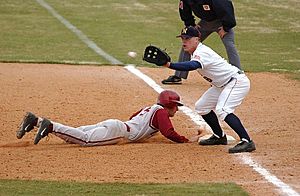
The team on the field tries to stop the batting team from scoring runs. The fielding team has a pitcher and a catcher. The other seven fielders can stand anywhere on the field. However, there are usually four players around the infield near the bases. Three outfielders stand in the outfield.
The four infielders are the first baseman, second baseman, shortstop, and third baseman. The first baseman and third baseman stand close to first base and third base. The second baseman and the shortstop stand on either side of second base.
The first baseman's job is to make force plays at first base. In a force play, another infielder catches a ball that has touched the ground. They then throw it to the first baseman. The first baseman must touch the batter or the base with the ball before the batter can touch first base. If they do, the batter is out. First basemen need to be quick and good at catching throws. First base is a very important position because many plays happen there.
The second baseman covers the area to the right of second base. They also help the first baseman. The shortstop covers the area between second and third bases. This is where right-handed batters often hit ground balls. The shortstop also covers second or third base and part of left field. The shortstop is usually the best fielder on the team. The third baseman needs a strong throwing arm. This is because batters often hit balls very hard towards third base. The third baseman must throw the ball very quickly to the first baseman to get the runner out.
The three outfielders are the left fielder, the center fielder, and the right fielder. They stand in left field, center field, and right field. Left field and right field are on the left and right sides when looking from home plate. Center field is straight ahead from home plate. Center field is very big, so the center fielder is usually the fastest player.
Teams can decide where to place their infielders and outfielders. Players often move to slightly different spots during a game. These changes are called "shifts." Fielders can shift at any time. One common shift is the defensive shift, where infielders move. They do this because they know some batters tend to hit the ball in a certain direction. Shifts can also make it easier to get a double play.
Pitching Techniques
Teams can change pitchers during a game. Pitchers are often changed because it is hard for one pitcher to throw for all nine innings. A pitcher can sometimes throw a "no-hitter," meaning no one on the other team gets a hit. A team can use many pitchers, but it is rare to use more than eight in one game.
The ways a pitcher throws the ball are called pitches. Many professional pitchers use two or more different pitches. Pitchers change their pitches to trick the batter. This makes it harder for the batter to know what to expect and hit the ball. Pitchers can make the ball move faster or slower, or closer or farther from the batter. There are many types of pitches, like the curveball, slider, change-up, and others.
When throwing the ball, the pitcher must touch the pitcher's rubber with their foot. The pitcher's rubber is on top of the mound. The pitcher cannot take more than one step forward when throwing. Many major-league pitchers can throw the ball up to 100 miles per hour (145 km/h). Throwing a baseball that fast can cause injuries. Pitchers often have surgery called Tommy John surgery for elbow injuries. It is named after Tommy John, the first pitcher to have it. Today, pitchers can often recover from these injuries much better than before this surgery.
The Batting Team's Goal
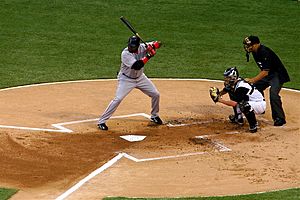
The batting team wants to score runs. The batting team sends its players to home plate in a special order. This order is called the lineup. Each team chooses its lineup at the start of the game. After the game begins, the team cannot change the order. However, a team can use a player who was not in the original lineup. This new player takes the place of an original player. The new player's name is written in the lineup where the original player's name was. After the ninth player has batted, the first player in the lineup starts again.
If a runner comes to home plate, they score a run. After scoring a run, the player leaves the field until it is their turn to bat again. So, a player can only score one run each time they bat.
Baseball has become a very popular sport in America. About 12 million people play baseball in the United States.
Baseball Terms
- Base: There are four points on the field players must run to. A player starts at Home plate and must go to each of the other bases in order. They then return to Home plate to score a run. The other bases are First base, Second base, and Third base. Home plate is made of hard rubber. The other bases are made of cloth. In professional baseball, the bases are 90 feet from each other. The bases on the field form the shape of a diamond.
- Baseline: The imaginary line between each of the bases in order. For example, from home plate to first base, then to second base, and so on.
- Base path: The area along the baseline where players run from base to base.
- Ball: A pitch that was thrown outside the strike zone and that the batter did not swing at.
- Strike: A pitch that was thrown inside the strike zone and that the batter did not swing at. It is also a strike if the batter swung at a pitch and missed, or if the batter hit the ball into foul territory (unless they already have two strikes).
- Dugout: The covered area where players and coaches who are not on the field sit.
- Bullpen: The area where pitchers warm up before they start playing or when they are not playing in the game.
- Outfield: The large grassy area beyond the bases where three players usually play.
- Grounder: A ball that bounces and rolls on the ground after being hit.
- Pop Fly: A ball that goes high in the air after being hit. It can be caught for an out or it can fall for a hit.
- Double Play: When the defense gets two outs on one play. This often happens when a ground ball is hit to an infielder with a runner already on base.
- Bunt: When the batter holds their bat out to try and tap the ball instead of swinging hard. A bunted ball usually does not go far. Pitchers often bunt because they are not as good at hitting. A bunt is also often used to help another runner on base move forward. This is called a "sacrifice" or "sacrifice bunt."
- Hit: When the batter hits the ball (thrown by the pitcher) into fair territory.
- Home Run: When the batter hits the ball outside the baseball field, they (and any runners on base) get to run all of the bases and score at home plate. The fielding team cannot stop them.
Interesting Facts About Baseball
- The baseball field is called the "diamond" because of the shape of the infield.
- The rarest thing in baseball is an unassisted triple play. This is when a single fielder completes all three outs by themselves. There have only been 15 unassisted triple plays in MLB history. This makes it rarer than a perfect game.
- Baseball was originally called rounders. This game came from England.
- The first official baseball game in the U.S. was played in Hoboken, New Jersey.
- Abner Doubleday was once said to have invented modern baseball. However, most baseball historians do not agree with this claim.
- Henry Chadwick (1824–1908) was an English-American sportswriter. He was a baseball statistician and historian. He is often called the "Father of Baseball" for his early reports and help in developing the game.
- The oldest ballpark still in use is Fenway Park in Boston. It is home to the Boston Red Sox and opened in 1912.
Images for kids
-
Jackie Robinson in 1945, with the era's Kansas City Royals, a barnstorming squad associated with the Negro American League's Kansas City Monarchs
-
Sadaharu Oh managing the Japan national team in the 2006 World Baseball Classic. Playing for the Central League's Yomiuri Giants (1959–80), Oh set the professional world record for home runs.
-
Babe Ruth in 1920, the year he joined the New York Yankees
-
A New York Yankees batter and a Boston Red Sox catcher at Fenway Park
-
Rickey Henderson—the major leagues' all-time leader in runs and stolen bases—stealing third base in a 1988 game
-
Cy Young—the holder of many major league career marks, including wins and innings pitched, as well as losses—in 1908. MLB's annual awards for the best pitcher in each league are named for Young.
-
Two players on the baseball team of Tokyo, Japan's Waseda University in 1921
-
The American Tobacco Company's line of baseball cards featured shortstop Honus Wagner of the Pittsburgh Pirates from 1909 to 1911. In 2007, the card shown here sold for $2.8 million.
See also
 In Spanish: Béisbol para niños
In Spanish: Béisbol para niños


